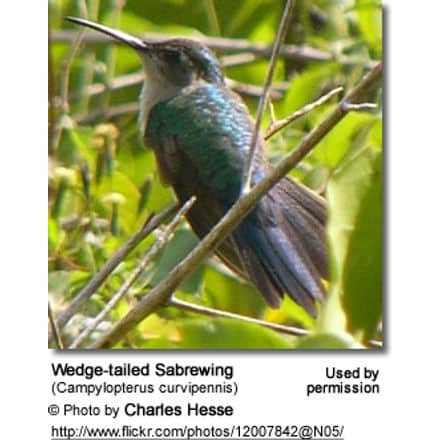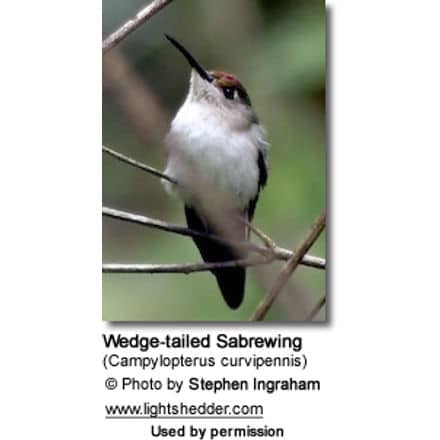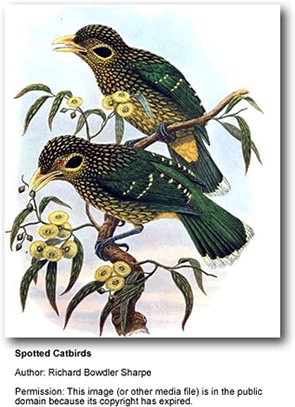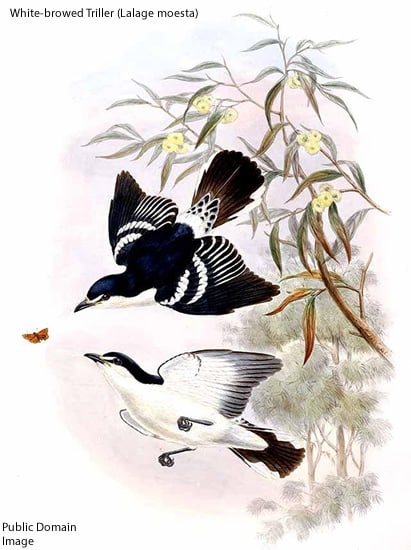Wedge-tailed Sabrewings
The Wedge-tailed Sabrewings (Campylopterus curvipennis) – also known as Curve-winged Sabrewings or White-tailed Sabrewings – are hummingbirds mostly found in Mexico. This species was named for its long, wedge-shaped tail.
Distribution / Range
The Wedge-tailed Sabrewing is native to Mexico, ranging from within 250 miles of the U.S. border in southern Tamaulipas to northern Oaxaca, as well as Belize, Guatemala and Honduras. This species is believed to be resident (non-migratory).
They inhabit humid to semi-arid evergreen forests, second-growth open woodlands and flowering gardens – – from near sea level to 1,400 meters or 4,500 ft above sea level.
Alternate (Global) Names
Czech: kolib?ík klínoocasý, Kolibrík slavíkový … Danish: Krumvinget Sabelvinge … Dutch: Wigsaartsabelvleugel, Wigstaartsabelvleugel, Witstaartsabelvleugel … Finnish: Kiilasapelikolibri … French: Campyloptère à queue large, Campyloptère pampa … German: Blaukron-Degenflügel, Nachtigallkolibri, Nachtigall-Kolibri … Italian: Campilottero codacuneata, Sciabolatore cuneato … Japanese: kusabiokembanehachidori, kusabiokenbanehachidori … Norwegian: Kilehalesabelvinge … Polish: zapylak klinosterny, Zapylak zielonosterny … Russian: ?????????? ????????? … Slovak: kolibrík klinochvostý … Spanish: Ala de sable coliancha, Ala de Sable Tijereta, Colibrí Ruiseñor, Fandangero Colicuña, Fandanguero Cola Cuña, fandanguero colicuña … Swedish: Kroksabelvinge

Subspecies ID and Ranges
- Campylopterus curvipennis curvipennis (Lichtenstein, 1830) – Nominate Race
- Range: Occur closest to the United States border. It is found in southeastern San Luis Potosí and southwestern Tamaulipas to northern Oaxaca in southeastern Mexico.
- ID: The bill is slightly longer than that of the subspecies Campylopterus curvipennis pampa
- Campylopterus curvipennis pampa (Lesson, 1832)
- Range: Yucatán Peninsula south to northern Guatemala, Belize and eastern Honduras.
Disputed Subspecies
- Long-tailed SabrewingCampylopterus (curvipennis) excellens (Wetmore, 1941) – Previously, this race was considered a subspecies, but it is mostly considered a separate species.
- Range: Occurs naturally in the forests around the Isthmus of Tehuantepec in southern Mexico.
Description
The Wedge-tailed Sabrewings are large hummingbirds that measure about 14 cm or 5.5 inches in length.
The plumage is metallic green on the back and pale grey to whitish below. The crown is glossy blue-violet, turning green at the nape (lower neck at the back). There are white spots behind the eyes. The cheeks are dark grey. The long, black bill is relatively straight with a slight down-curve. The lower bill has aflesh-colored at base. The legs are dark brown.
Male and female identification:
The male weighs between 5 – 7.5 grams (0.18 – 0.26 ounces). He has a long, dark green, wedge-shaped tail.
The female weighs about 7.1 grams (0.3 ounces). The female’s tail is shorter, dark green in color with white edges.
Juveniles look like adults, except the plumage is slightly duller.
Similar Species
The Wedge-tailed Sabrewings resembles the Long-tailed Sabrewing; except the latter is larger and the male has a longer tail; and its plumage is paler. Also, the Wedge-tailed Sabrewing can be identified by its distinctive wedge-shaped tail.
Calls / Vocalizations
Their calls include a persistent, insect-like chippingt hat can go on for several minutes before breaking into a series of excited warbled or gurgling notes; as well as squeaks, squeals, and a shrill, nasal peek.
Their songs are typically heard from dense vegetation. Male Wedge-tailed Sabrewingssing year-round, sometimes in small groups – particularly in the breeding season, when males are competing for the attention of females.
Nesting / Breeding
The Wedge-tailed Sabrewings typically breeds from March to July.
Hummingbirds in general are solitary and neither live nor migrate in flocks; and there is no pair bond for this species – the male’s only involvement in the reproductive process is the actual mating with the female.
During the breeding seasons, male Sabrewings typically gather in leks (competitive mating display) consisting of up to 10 males (most often 4 to 6). The males will sing to the females to gain their goodwill. They may fly in front of them in a u-shaped pattern.
The male will separate from the female immediately after copulation. One male may mate with several females. In all likelihood, the female will also mate with several males. The males do not participate in choosing the nest location, building the nest or raising the chicks.
The female alone constructs the fairly large cup-shaped nest using various plant fibers found in her environment. These fibers are woven together and green moss is attached to the outside for camouflage. The nest is usually placed in a hidden location in a shrub, bush or tree, often on a low, thin horizontal branch situated over a stream. The nest is lined with soft plant fibers, animal hair and feather down, and she strengthens the structure with spider webbing and other sticky material that give the nest an elastic quality to allow it to stretch to double its size as the chicks grow and need more room.
The typical clutch consists of one white egg, which she incubates alone. The hatchlings are blind, immobile and without any down.
The female alone protects and feeds the chicks with regurgitated food (mostly partially-digested insects since nectar is an insufficient source of protein for the growing chicks). The female pushes the food down the chick’s throats with her long bill directly into their stomachs.
As is the case with other hummingbird species, the chicks are brooded only the first week or two, and left alone even on cooler nights after about 12 days – probably due to the small nest size. The chicks leave the nest when they are about 20 days old.
Feeding hummingbird chicks is difficult as their natural diet consists of partially-digested insects which the mother pushes down the chick’s throats with her long bill directly into their stomachs.
Diet / Feeding
The Sabrewings primarily feed on nectar taken from a variety of brightly colored, scented small flowers of trees, herbs, shrubs and epiphytes.
Hummingbird Resources
- Hummingbird Information
- Hummingbird Amazing Facts
- Attracting Hummingbirds to Your Garden
- Hummingbird Species
- Feeding Hummingbirds





